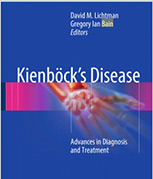Kienbock's Disease

Kienbock's disease is a condition in which the lunate, one of the small bones of the wrist loses its blood supply leading to death of the bone. This results in pain, stiffness, and degenerative changes in the wrist joint. Professor Bain has published a book on this interesting topic. (link)
The exact aetiology of Kienbock's disease is unknown. Symptoms of Kienbock's disease include
- painful and swollen wrist with decreased motion
- reduced grip strength
- difficulty or pain in turning the hand upward and
- tenderness in the area over the back of wrist near the lunate bone
Kienbock's disease can be diagnosed by reviewing your medical history and by performing a thorough physical examination of your hand and wrist. Professor Bain may also order an MRI, CT scan and X-rays to confirm the diagnosis.
Treatment depends upon the severity and stage of the disease. In the very early and less severe stage, treatment may involve anti-inflammatory medications or immobilisation. Professor Bain may recommend surgery if the pain is not relieved with the conservative treatment. The aim of surgery is to protect or reconstruct the lunate and may involve the following:
- Revascularisation involves insertion of a vascularised graft into the lunate bone.
- Joint levelling refers to lengthening or shortening of the forearm bones (ulna and radius).
- Fusion: Limited wrist arthrodesis, also called fusion is a procedure in which the wrist joint is stabilised or immobilised by fusing some of the small bones of the wrist.


